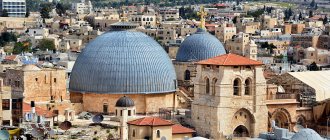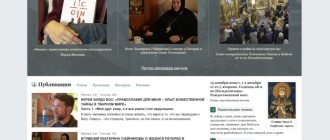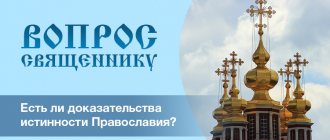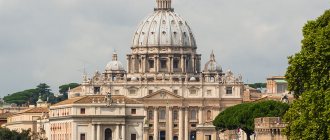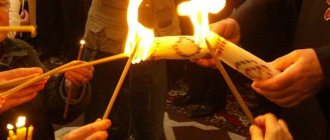preaching the doctrine of God the Savior in the lands of Great Scythia near the future Kyiv, 1st century AD.
e. Orthodoxy (Orthodox Christianity)
- one of the names of monotheism and Christian doctrine, the doctrine of the one God-Savior, widespread almost exclusively in Slavic languages (in other languages of the world, the Greco-Roman term “orthodoxy”, close but not identical in meaning, is usually used instead). The name is most often explained as "the glorification of truth" (where truth is usually understood to mean God - the only Eternal Truth and Righteousness) and as "the right glorification of God."
It is worth noting that in the modern world many people, especially those unfamiliar with the original teaching, put a different meaning into it - just one of the directions within Christianity, which took shape during the reign of Rome.
The historical center of Orthodoxy in ancient times is considered to be the city of Constantinople - the capital of the Kingdom of Rome in the Christian era. Now this concept is not popular among all believers who believe that God is present everywhere, the main thing is to believe in him.
Orthodoxy as a movement arose after the great schism of the Christian Church in 1054 AD. e., when it was previously united and divided into two parts, one of which began to use primarily the self-name Catholic, and the other Orthodox. Then Protestantism was separated from Catholicism.
Orthodoxy is widespread mainly in Russia, Georgia, Cyprus, Eastern European countries and the Balkans.
According to the Institute of Sociology of the Russian Academy of Sciences, 79% of Russian citizens are Orthodox. According to the American Pew Research Center, 71% of Russians are Orthodox.[1]
[edit] Creed
The doctrine of the Orthodox Church is described in the Creed
:
I believe in one God the Father, Almighty, Creator of heaven and earth, visible to all and invisible. And in one Lord Jesus Christ, the Son of God, the only begotten, who was born of the Father before all ages; Light from Light, true God from true God, born, uncreated, consubstantial with the Father, to Whom all things were. For our sake, man and our salvation came down from heaven and became incarnate from the Holy Spirit and the Virgin Mary, and became human. She was crucified for us under Pontius Pilate, and suffered and was buried. And he rose again on the third day according to the Scriptures. 6And ascended into heaven, and sits at the right hand of the Father. And again the coming one will be judged with glory by the living and the dead, His Kingdom will have no end. And in the Holy Spirit, the Lord, the Life-Giving One, who proceeds from the Father, who with the Father and the Son is worshiped and glorified, who spoke the prophets. Into one Holy, Catholic and Apostolic Church. I confess one baptism for the remission of sins. I hope for the resurrection of the dead and the life of the next century. Amen
[edit] Differences from Catholicism
- filioque
- dogma of papal infallibility
- dogma of the virgin birth and ascension of the Virgin Mary
- differences in rituals
Principles and morals of Orthodoxy
Literally, “Orthodoxy” is correct glorification, or correct opinion. The philosophy of religion is the belief in one God, the Father, the Son and the Holy Spirit (God the Trinity).
The foundation in the doctrines of Orthodoxy is the Bible or “Holy Scripture” and “Holy Tradition”.
The connection between the state and Orthodoxy is quite distributed and understandable: the state does not make adjustments to the teachings of the church, and the church does not aim to control the state.
All principles, history, and laws are unlikely to be present in the thoughts and knowledge of every Orthodox person, but this does not interfere with faith. What does Orthodoxy teach at the philistine level? The Lord is the bearer of supreme intelligence and wisdom. The teachings of the Lord are irrefutably true:
- Mercy is trying to alleviate the sorrows of an unhappy person on your own. Both sides need mercy - the giver and the receiver. Mercy is helping those in need, a deed pleasing to God. Mercy is kept secret and not spread. Also, mercy is interpreted as loaned to Christ. The presence of mercy in a person means that he has a good heart and is morally rich.
- Perseverance and vigilance - consists of spiritual and physical strength, constant work and development, vigilance for good deeds and serving God. A persistent person is one who brings any task to the end, walking hand in hand with faith and hope, without losing heart. Keeping the Lord's commandments requires work and perseverance. Human kindness alone is not enough to spread goodness; vigilance and perseverance are always necessary.
- Confession is one of the Lord's sacraments. Confession helps to receive the support and grace of the Holy Spirit, strengthens faith. In confession, it is important to remember each of your sins, tell and repent. The one who listens to confession assumes the responsibility of forgiveness of sins. Without confession and forgiveness, a person will not be saved. Confession can be considered a second baptism. When committing sins, the connection with the Lord given at baptism is lost; during confession, this invisible connection is restored.
- The Church – through teaching and preaching, presents the grace of Christ to the world. In the communion of his blood and flesh, he unites man with the creator. The Church will not leave anyone in grief and misfortune, will not reject anyone, will forgive the repentant, will accept and teach the guilty. When a believer passes away, the church will not abandon him either, but will pray for the salvation of his soul. From birth to death, throughout life, in any situation, the church is nearby, opening its arms. In the temple, the human soul finds peace and tranquility.
- Sunday is a day of serving God. Sunday must be revered sacredly and the works of God done. Sunday is a day when you should leave everyday problems and everyday fuss and spend it with prayer and reverence for the Lord. Prayer and visiting the temple are the main activities on this day. You need to beware of communicating with people who like to gossip, use foul language, and tell lies. Anyone who sins on Sunday aggravates his sin 10 times.
[edit] History
[edit] Background to Orthodoxy in Russia
The baptism of Rus' (including the territories that are part of modern Russia) occurred in 988. Over the next centuries, the dioceses on the territory of modern Russia were under the complete control of the Kyiv Metropolitan.
[edit] Orthodoxy in the Russian Empire
In the Russian Empire, Orthodoxy was considered one of the foundations of the state, along with autocracy and nationality. Conversion from Orthodoxy to other religions or directions of Christianity was a criminal offense, and therefore Old Believers and Protestants, if they were seen promoting their views, were exiled and imprisoned. If a person of a non-Orthodox confession was born from non-Orthodox parents (for example, Jews, Tatars, and so on), the very fact of his confession was not punished, but the state financed the missionary activities of the Orthodox Church; conversion to Orthodoxy also gave career advantages.
[edit] Orthodoxy in the USSR
[edit] Current state
What is the difference between Orthodoxy and Catholicism?
Orthodoxy and Catholicism have always been close to each other, but at the same time, fundamentally different. Initially, Catholicism is a branch of Christianity.
Among the differences between Orthodoxy and Catholicism, the following can be highlighted:
- Catholicism professes that the Holy Spirit comes from the Father and the Son. Orthodoxy professes that the Holy Spirit comes only from the father.
- The Catholic Church accepts the main position in religious education leading to the fact that the mother of Jesus, Mary, was not touched by original sin. The Orthodox Church believes that the Virgin Mary, like everyone else, was born with original sin.
- In all matters of faith and morals, Catholics recognize the primacy of the Pope, which Orthodox believers do not accept.
- Adherents of the Catholic religion make gestures describing the cross from left to right, adherents of the Orthodox religion do the opposite.
- In Catholicism, it is customary to commemorate the deceased on the 3rd, 7th and 30th day from the day of death, in Orthodoxy - on the 3rd, 9th, 40th.
- Catholics are ardent opponents of contraception; Orthodox Christians accept some of the types of contraception used in marriage.
- Catholic priests are celibate; Orthodox priests are allowed to marry.
- The sacrament of marriage. Catholicism rejects divorce, but Orthodoxy allows it in some individual cases.
Criticism of Orthodoxy[edit]
Orthodoxy was criticized: by historical Christian churches of other denominations (starting with the schism of 1054 - primarily by Catholicism, after the Union of 1589 - by Greek Catholic polemicists, from the 19th-20th centuries - by Protestants); from representatives of schisms within Orthodoxy itself (Old Believer criticism of New Believer Orthodoxy); from other religions, along with other Christian denominations (Islam, Judaism, Buddhism); from the side of the rationalistic religious and moral approach (for example, Tolstoyism), from the side of agnosticism; on the part of atheism, along with all other religions. For examples of criticism, see the relevant articles.
Criticism and denial of the Nicene Creed[edit]
- Leo Tolstoy “The entire Nicene symbol is a weave of unreasonable and fantastic statements” Tolstoy Lev Nikolaevich. About religious tolerance
- Mormons “Mormons do not accept the Nicene Creed because it was man-made and not divinely given. At the church's 2007 general conference, President Gordon B. Hinckley stated, “Personally, I don't understand him. In my opinion, this creed is confusing."[8]
Dogmatics[edit]
- Consubstantial Persons of the Holy Trinity (God the Father, God the Son, Holy Spirit) (against the Arians)
- Theotokos (Theotokos) Virgin Mary (vs. Nestorians)
- The God-man Jesus Christ, in whom two natures were co-present: divine (against the Monophysites) and human, and two wills (against the Monothelites).
- The Sinlessness of the God-Man
- Inerrancy of the Church
- Icon veneration (against iconoclasts)
- Belonging to the Church ( churchlessness
), achieved through baptism and communion. - Deification ( theosis
) as the goal of human life. - Faith in angels and the help of saints.
Basic canonical norms and institutions:
- Hierarchical priesthood, which has 3 degrees: bishop, presbyter, deacon. A necessary condition for the legitimacy of the hierarchy is direct apostolic succession through a series of ordinations. Each bishop (regardless of the title he holds) has full canonical authority within his jurisdiction (diocese).
- Institute of Monasticism. Includes the so-called black clergy, which has played a leading role in all spheres of the life of the Church since the 4th century.
- Established calendar fasts: Great (pre-Easter 48-day), Petrov, Assumption, Nativity, together with holidays, make up the liturgical year.
- Fasts: Great (pre-Easter 40-day), Petrov, Uspensky, Rozhdestvensky.
Notes[edit]
- Glubokovsky N. Orthodoxy according to its essence
. St. Petersburg, 1914; M., 1991, pp. 11 - 13 - In Orthodox terminology, schismatics (schismatics) are called those who have broken away from the One Catholic Apostolic Church, but who have not, unlike heretics, distorted dogmas (there is a distortion of canonical norms)
- This understanding of holiness does not apply to Anglicans and Lutherans
- The classification of Seventh-day Adventists as a Christian denomination is controversial. According to many researchers, this movement, along with Jehovah's Witnesses and Mormons, is not Christian.
- There are a number of churches in Ukraine that call themselves Orthodox, unrecognized by other Orthodox churches
- The Belarusian Autocephalous Church operates in Belarus, which has not received recognition from other Orthodox churches.
- Currently, there is a dispute about the attribution of Estonia to the canonical territory of the Russian Orthodox Church MP; there are two Orthodox churches in Estonia - the Estonian Orthodox Church of the Moscow Patriarchate and the Estonian Orthodox Church of the Patriarchate of Constantinople
- Liahona, 2007, no. 5, p. 83
The meaning of the term and the boundaries of the concept[edit]
Professor of the Imperial St. Petersburg Theological Academy N. N. Glubokovsky:
Orthodoxy wants to be the complete revelation of Christianity, so that the latter is expressed in it adequately and, therefore, correctly. In this sense, Orthodoxy is a “right confession” - ορθο-δοξία - because it reproduces in itself the entire intelligible object, sees itself and shows it to others in the “correct opinion” in all its objective richness and with all its features. <…>
In its inner hope, Orthodoxy sees itself as Christianity in its original fullness and intact integrity. It is fundamentally distinguished from other Christian confessions not as truth from error, but, in fact, as a whole compared to parts. The latter are already separated from it and, in order to justify and ensure their autonomy, are forced to insist on direct separation with a sharp highlight of their distinctive properties and such dissimilarity that excludes mixing and transmission. By its very integrity, Orthodoxy does not feel an internal need for this, for it carries within itself all the parts and has neither the need nor the desire to differentiate from them. <…>Orthodoxy does not have “symbolic books” in the technical sense <...> It considers itself to be right, or the genuine teaching of Christ in all its originality and integrity, and then - what special distinctive doctrine can it have, other than the Gospel of Christ?! <...> Orthodoxy appeals to old, primordially Christian norms and does not indicate for itself special “symbolic books”, because it has nothing symbolically new in dogmatic terms compared to the era before the conclusion of the seven Ecumenical Councils. This shows that Orthodoxy preserves and continues the original apostolic Christianity through direct and continuous succession. In the historical flow of Christianity throughout the universe, this is the central stream, coming from the very “fountain of living water” (Rev. 21.6) and not deviating throughout its entire length until the end of the world.[1]
Coexistence of Orthodoxy with other religions
Speaking about the relationship of Orthodoxy to other religions, it is worth emphasizing such traditional religions as Judaism, Islam and Buddhism.
- Judaism. The religion is exclusively of the Jewish people. It is impossible to belong to Judaism without Jewish origin. For a long time, the attitude of Christians towards Jews has been quite hostile. Differences in understanding the person of Christ and his story greatly divide these religions. Repeatedly, such hostility led to cruelty (Holocaust, Jewish pogroms, etc.). On this basis, a new page began in relations between religions. The tragic fate of the Jewish people forced us to reconsider our relationship with Judaism, both at the religious and political levels. However, the general basis is that God is one, God the Creator, a participant in the life of every person, which today helps such religions as Judaism and Orthodoxy to live in harmony.
- Islam. Orthodoxy and Islam also have a difficult history of relationship. Prophet Muhammad was the founder of the state, military leader, and political leader. Therefore, religion is very closely intertwined with politics and power. Orthodoxy is a free choice of religion, regardless of nationality, territoriality and language a person speaks. It should be noted that in the Koran there are references to Christians, Jesus Christ, the Virgin Mary, these references are respectful and respectful. There are no calls for negativity or blame. At the political level, there are no conflicts of religions, but this does not exclude confrontations and hostility in small social groups.
- Buddhism. Many clergy reject Buddhism as a religion because it has no understanding of God. Buddhism and Orthodoxy have similar features: the presence of temples, monasteries, prayers. It is worth noting that the prayer of an Orthodox person is a kind of dialogue with God, who appears to us as a living Being from whom we expect help. A Buddhist's prayer is more of a meditation, a reflection, an immersion in one's own thoughts. This is a fairly good religion that cultivates kindness, calmness, and will in people. In the entire history of the coexistence of Buddhism and Orthodoxy, there have been no conflicts, and it is impossible to say that there is potential for this.
Non-canonical Orthodox churches[edit]
These include churches that, for one reason or another, have fallen into schism.
Orthodox churches not recognized by other Orthodox Churches[edit]
- Ukrainian Orthodox Church (the so-called “Kiev Patriarchate”) (unrecognized even by the pro-Catholic Patriarch of Constantinople)
- Belarusian Autocephalous Orthodox Church
- Macedonian Orthodox Church
- Montenegrin Orthodox Church
- Ukrainian Autocephalous Orthodox Church
Old Believer churches[edit]
Churches that did not recognize the reform of Patriarch Nikon (XVII century).
- Priesthood
Currents that recognize the priesthood and consecrated succession.
- Russian Orthodox Old Believer Church (Belokrinitskoye Consent)
- Russian Ancient Orthodox Church (Novozybkov Consent)
- Bespovostvo
Currents that believe that consecrated succession was stopped with the death of the last bishop who did not recognize the reform of Patriarch Nikon.
- Old Orthodox Pomeranian Church
- Fedoseevtsy
- Spasovtsy
- Netovtsy
Literature[edit]
- “Works” by A. S. Khomyakov (vol. II, “Theological Works”, M., 1876);
- “Historical. and critical experiments" prof. N. I. Barsova (St. Petersburg, 1879; article “New Method”);
- Overbeck's articles on the meaning of Orthodoxy in relation to the West. religions ("Christian Reading", 1868, II, 1882, 1883, 1 - 4, etc.) and "Orthodox Review", (1869, 1, 1870, 1 - 8);
- Goette, “Fundamentals of Orthodoxy” (“Faith and Reason”, 1884, 1, 1886, 1);
- archim. Fedor, “On Orthodoxy in relation to modernity” (St. Petersburg, 1861);
- prot. P. A. Smirnov, “On Orthodoxy in general and in particular in relation to the Slavic peoples” (St. Petersburg, 1893);
- “Collected spiritual and literary works” prot. I. Yakhontov (vol. II, St. Petersburg, 1890, article “On the Orthodoxy of the Russian Church”);
- N. I. Barsov, “The Question of the Religiosity of the Russian People” (St. Petersburg, 1881).
Option 2
One of the world's largest religions, and indeed the most widespread, is Christianity. This religion, which dates back more than 2 thousand years, is represented in all countries of the world.
What is the essence of Christianity
Christianity is a humane religion. According to its canons, a person must lead a righteous life in accordance with the 10 commandments, which are aimed at kindness and love for God and neighbors.
The book of the Bible, especially the New Testament, is sacred to Christians. Christians believe in one God and his son Jesus Christ, who gave his life and was crucified on the cross for the salvation of mankind.
In his life, Jesus did only good deeds: he treated the sick, helped the poor. At the same time, he lived very modestly and did not set his sights on wealth and power. The main thing for him was to save humanity and their souls. For this salvation, he sacrificed himself and Christians should take this kindness and love for others as an example, and also believe in his teaching.
When and where did Christianity originate?
Christianity began in the 1st century AD. in the homeland of Jesus Christ, in Palestine, which was under the yoke of the Roman Empire. Rome, conquering new lands, imposed unbearable oppression on the peoples of these lands, and the struggle against Roman lawlessness was suppressed. And with the birth of Jesus Christ, a new movement appeared in the struggle for justice, in which everyone, rich and poor, was considered equal before one God. This movement in the name of Christ was called Christianity, and its followers were called Christians.
Christians were persecuted by the rulers and dealt with very cruelly. Gathering in communities secretly, mostly in caves, they were true to their ideals and refused to believe in the Roman gods or make sacrifices to them.
The sermons of Jesus Christ and his followers had a beneficial effect on the spread of this religion, and his martyrdom and miraculous resurrection further strengthened people's faith in one God. And not only the poor, but also rich people took the side of Christianity, because they were satisfied with the ideas of humility and patience. So in 325, Emperor Constantine recognized this religion as the state religion in Rome. As the years passed, the religion spread throughout the world and began to dominate other religions.
Currents in Christianity
Although the ideas of Christianity are united, there are differences in the essence of the doctrine. Christianity is divided into three branches: Orthodoxy, Catholicism and Protestantism. Within each branch there is also divergence in the teachings of the faith. But the essence of religion is the same.
Autonomous Orthodox churches[edit]
There are also autonomous Orthodox churches that are subordinate to some autocephalous church (for example, the Sinai Church is dependent on the Jerusalem Church). All world Orthodoxy is organized into these 15 autocephalous and 6 autonomous churches, which is a feature of Orthodoxy.
- Sinai Orthodox Church
- Finnish Orthodox Church
- Estonian Orthodox Church
- Chinese Orthodox Church
- Japanese Orthodox Church
- Ukrainian Orthodox Church
